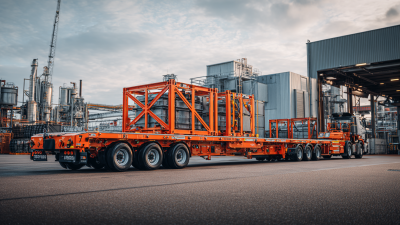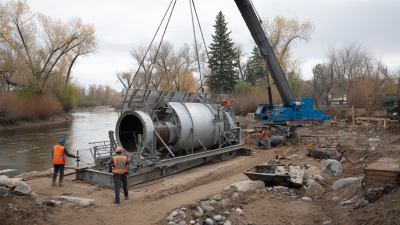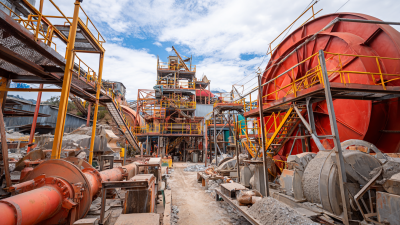

When it comes to the oil and gas industry, making sure that vessels perform well is a big deal. It really impacts how smoothly operations go and can even save a ton of money. Recent reports show that inefficient separation processes can eat up as much as 30% of the total operational costs—that’s a huge chunk! That’s why using advanced desanding solutions like Hycos Desanding For Vessel can be a game-changer. These tools help remove more particulates and contaminants from the produced fluids, which in turn cuts down expenses.

Shanghai Shangjiang Petroleum Engineering Equipment Co., Ltd. has been at the forefront of this, coming up with innovative separation and filtration tech—especially cyclone separation products. By adopting solutions like Hycos Desanding For Vessel, companies can seriously boost vessel performance, which means more reliable assets and better productivity overall. It’s all about working smarter and making things run more efficiently, you know?
Desanding might not be the most exciting topic out there, but trust me, it’s a big deal when it comes to keeping vessels running smoothly—especially in industries dealing with hydrocarbons and water treatment. Getting rid of those pesky particles isn’t just about cleaner operation; it actually helps extend the life of your equipment too. Recent research actually emphasizes how important it is to get the flow conditions just right during desanding. For example, keeping the inlet flow rate somewhere around 40 to 50 liters per minute in hydrocyclones has been shown to really boost how well they separate sand and other solid stuff. It's pretty fascinating how such a simple tweak can make a difference, huh?
Another thing that’s super critical is understanding how oil and particle clumps interact during these processes. When dealing with three-phase feeds—oil, water, and solids—study after study shows that how you design and operate your hydrocyclones can change the game on separation performance, especially under different conditions. That’s why having advanced desanding solutions isn’t just a nice-to-have; it’s essential for protecting key components like downhole pumps. In the real world, this stuff really matters—effective desanding prevents equipment from failing prematurely, keeping vessels reliable and running efficiently for longer. So, in a nutshell, good desanding practices are key to keeping everything working smoothly and avoiding costly downtime.
Hycos Desanding Solutions have really become a vital part of making vessels run smoother in the marine world. Basically, these solutions are great at quickly and effectively separating out solids from produced water — which helps cut down on equipment wear and keeps things running without a hitch. What I like about Hycos Desanding really stands out is their ability to remove solids efficiently, adapt to different operating conditions, and easily fit into existing systems. Thanks to recent tech advancements, operators can see big improvements in managing water and keeping their vessels in good shape.
Plus, it's clear that companies in the oil and gas sector are constantly pushing forward with new separation and filtration tech. The latest cyclone separation products keep getting better at performance and reliability — super important when operating in tough marine environments. By adopting innovative solutions like Hycos Desanding, operators aren’t just managing produced water more effectively; they’re also boosting overall vessel performance and reducing the chance of operational hiccups. It’s all about staying ahead and making things run more smoothly, even in challenging conditions.
When it comes to implementing Hycos desanding technology, there’s no one-size-fits-all approach. You really want to start with a good look at how the vessel is doing right now—focusing on any issues with sand and other tiny particles that might be causing trouble. This initial check helps you get a clear picture of what’s needed and what kind of desanding solution will work best for that particular vessel. During this phase, keeping an eye on real-time data from sand monitoring systems can be a game-changer. It provides valuable insights into how much sand is coming in and lets you see whether existing filters or separators are doing their job properly.
After you’ve got a solid understanding of the current situation, the next step is choosing the right Hycos desanding equipment. This might mean going for systems that use cutting-edge filtration tech, designed to work efficiently and reduce downtime. Making sure the new gear is installed correctly and aligned properly is super important because it needs to fit seamlessly with what’s already on board. Once everything’s set up, don’t forget to keep up with regular maintenance and performance checks. Staying proactive like this helps your vessel handle changing sand levels smoothly, keeping things running reliably and avoiding surprises down the road.
Keeping an eye on vessel performance and making sure everything runs smoothly isn’t just important — it’s a must, especially in sectors like oil and gas where sediment, sand, and other debris can really throw a wrench in the works. I read a report from the International Maritime Organization a while back, and it said that sediment buildup can cut a ship’s efficiency by anywhere between 15 to 25%. That’s a big deal because it means more fuel burned and higher costs overall. That’s why lots of operators are turning to desanding solutions, like those offered by Hycos. They help you stay ahead of the game by keeping tabs on sediment levels in real-time, so your vessel always stays within the optimal performance range.

These desanding systems do a pretty good job at removing sand and tiny particles from the ship’s systems. Not only does that mean better fuel economy, but it also helps extend the lifespan of key parts, saving headaches down the line. The EIA’s 2021 report pointed out that ships using advanced desanding tech can cut maintenance costs by up to 20%. And with continuous monitoring systems, crews can make quick, informed decisions on when to do desanding — reducing unexpected downtime and making everything run more smoothly. When you add these tech solutions into the mix, you’re basically setting your vessels up to be more efficient, compliant, and kinder to the environment overall.
When it comes to running ships and other maritime operations, making sure vessels perform at their best is super important—not just for efficiency, but also to keep costs in check. Recently, Hycos Desanding Solutions have really shaken things up in how boats deal with the pesky problem of sand and sediment buildup. There are a bunch of case studies showing just how much these solutions have boosted performance across different vessels—like cutting down maintenance downtime and making them last longer overall.

Take one example: a mid-sized tanker that kept struggling with sediment clogging up its ballast tanks. After they installed Hycos Desanding tech, they saw about a 30% drop in maintenance expenses and a boost in fuel efficiency—up to 15%! That made everything run smoother and even helped them be a bit kinder to the environment. Then there’s another story about an offshore supply vessel. After installing the Hycos system, it handled cargo way more efficiently—even in rough seas. Basically, it made operations way smoother, no matter the conditions.
All in all, these stories highlight just how much Hycos Desanding Solutions can genuinely help improve vessel performance. By tackling sediment issues head-on, ships can operate better, save some money, and stay reliable—even when the maritime environment throws challenges their way.
: Desanding is the process of removing unwanted particulate matter, such as sand, from vessels. It is crucial for optimizing vessel performance as it enhances operational efficiency and prolongs the life of critical equipment.
The optimal inlet flow rate for hydrocyclones during desanding operations is between 40–50 L/min, as this maximizes separation efficiency and allows for effective removal of sand and other particulates.
Sediment accumulation can reduce vessel efficiency by 15-25%, leading to increased fuel consumption and operational costs.
Advanced desanding solutions can reduce maintenance costs by up to 20% by effectively removing sand and particulate matter, thus prolonging the life of vital components and reducing downtime.
Continuous monitoring systems provide real-time data on sediment levels, enabling crews to make informed decisions about desanding needs, which mitigates the risk of unexpected downtime and improves overall operational reliability.
A medium-sized tanker implemented Hycos Desanding technology, resulting in a 30% reduction in maintenance costs and up to a 15% increase in fuel efficiency. This demonstrates the significant impact of desanding solutions on operational performance.
Benefits include reduced maintenance downtime, enhanced operational longevity, improved fuel efficiency, and a positive impact on the environmental footprint of vessels.
The interaction of oil-particle aggregates is crucial as it influences the separation performance of desanding under varying conditions, highlighting the need for effective design and operation of hydrocyclones.
Managing sediment levels is essential to maintain optimal performance, reduce operational costs, and ensure vessels operate efficiently and responsibly in compliance with environmental standards.
Hey, if you're into marine tech or just curious about how ships stay efficient, you might find the article 'How to Optimize Vessel Performance with Hycos Desanding Solutions' pretty interesting. It really stresses how important desanding is for keeping vessels running smoothly and boosting performance. The article takes a close look at what makes Hycos Desanding solutions stand out—like how effectively they can remove those pesky particles that can slow everything down. Plus, it walks you through a clear, step-by-step guide on how to implement this tech into existing systems, making it seem doable even if you're not a total tech wiz.
They also talk about how crucial it is to keep an eye on things with regular checks and maintenance to keep that high performance going strong. To back this up, there are some real-world case studies showing how vessels have been significantly optimized with Hycos Desanding. It’s pretty exciting stuff! Oh, and by the way, Shanghai Shangjiang Petroleum Engineering Equipment Co., Ltd.—the company behind this—really gets how important such innovative solutions are, especially in the oil and gas industry. They’re definitely positioning themselves as big players in helping improve operational efficiency in the sector.






